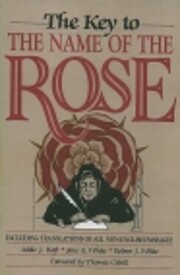

Auf ein Miniaturbild klicken, um zu Google Books zu gelangen.
|
Lädt ... The Key to The Name of the Rose: including translations of all non-English passages (Original 1987; 1987. Auflage)von Adele J. Haft (Autor), Jane G. White (Autor), Robert J. White (Autor), Thomas Cahill (Vorwort)
Werk-InformationenThe Key to The Name of the Rose: Including Translations of All Non-English Passages von Adele J. Haft (1987)
 Keine Keine aktuelle Diskussion zu diesem Buch. Highly recommended for anyone reading or intending to read Umberto Eco's The Name of the Rose, but especially for anyone feeling frustrated with and by the book (I was ready to give up, but this book has made me reconsider). The essays and information included are very informative, and the large section of translations of all of the non-English passages are amazing and a godsend to those of us who are not fluent in Latin, Greek, Italian etc., but want to know, or need to know what all, or at least most of the non-English passages mean. The Key to the Name of the Rose includes annotated translations of all the Latin that Eco included in his text . The Key also provides a brief chapter on the interaction among semiotics, detective mysteries, and medieval thought and a brief chronology of the Middle Ages. The pearl, however, is the chapter of historical annotations including brief descriptions of the saints, heretics, mythological allusions, and a multitude of medieval figures, both the important and the insignificant. The authors provide just the right amount of information for most readers; a paragraph or two on most. The book's central historical figures, Michael of Cesena, Ubetino of Casale, and Bernard Gui are all there, but so are many others. Peter Abelard, Bernard of Clairvaux, and Prester John each merit an entry. I still don't understand why Eco wouldn't provide translations at the bottom of the page. In the recent translation by Richard Pevear and Larissa Volokhonsky of War and Peace (Vintage Classics), the hundreds of French passages were included as in the original text, but translated at the bottom of the page without harm to the reader's appreciation that French was the language of the noble class. However, if he had, then perhaps this exceptional little guide would never have been published. I wish I'd had this guide before I read The Name of the Rose, but it is worthwhile in its own right and an encouragement to re-read Eco's mystery. The Key to the Name of the Rose isn't necessary to understand the plot of The Name of the Rose, and the essays bookending the Key definitely don't do any of the interpretive heavy lifting for you, but it was a concise, handy reference work to have available while reading Eco's novel. In addition to the essays, the Key gave a bit more context to the intertwined theological, philosophical and political disputes running through the book by means of a concise glossary and occasional commentary on specific allusions in the text. The unadorned translations of non-English passages -- chiefly Latin, with a sprinkling of German and pidgin Salvatorese -- often weren't terribly enlightening, though the effort put into explaining a throw-away syllogism joke was entertaining. keine Rezensionen | Rezension hinzufügen
Nachschlage- oder Begleitwerk zu
Umberto Eco's The Name of the Rose is a brilliant mystery set in a fictitious medieval monastery. The text is rich with literary, historical, and theoretical references that make it eminently re-readable. The Key makes each reading fuller and more meaningful by helping the interested reader not merely to read but also to understand Eco's masterful work. Inspired by pleas from friends and strangers, the authors, each trained in Classics, undertook to translate and explain the Latin phrases that pepper the story. They have produced an approachable, informative guide to the book and its setting--the middle ages. The Key includes an introduction to the book, the middle ages, Umberto Eco, and philosophical and literary theories; a useful chronology; and reference notes to historical people and events. The clear explanations of the historical setting and players will be useful to anyone interested in a general introduction to medieval history. Adele J. Haft is Associate Professor of Classics, Hunter College, City University of New York. Jane G. White is chair of the Department of Languages, Dwight Englewood School. Robert J. White is Professor of Classics and Oriental Studies, Hunter College, City University of New York. Keine Bibliotheksbeschreibungen gefunden. |
Aktuelle DiskussionenKeineBeliebte Umschlagbilder
 Google Books — Lädt ... Google Books — Lädt ...GenresMelvil Decimal System (DDC)853.914Literature Italian Italian fiction 1900- 20th Century 1945-1999Klassifikation der Library of Congress [LCC] (USA)BewertungDurchschnitt: (3.75) (3.75)
Bist das du?Werde ein LibraryThing-Autor. |
||||||||||||||||||||||||||||||||||||||||||||||||||||||||||||||||||||||||||||||||||||||||||||||||||||||||||||||||||||||||||||||||||||||||
I read this sitting at the Louisville Science Center while my wife’s nephew played and explored. It was a gorgeous day and reading the book reminded me of my love for Eco and his tragic optimism. (